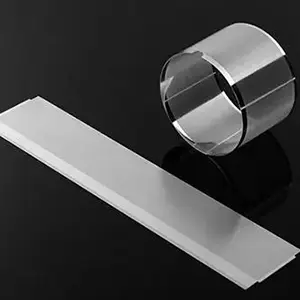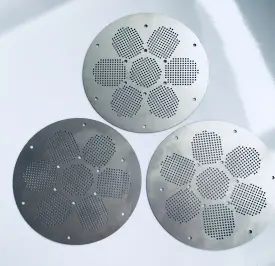Aluminium Etching
What is aluminum etching?
Aluminum etching, also known as chemical etching, is a process used to selectively remove material from aluminum surfaces using a strong chemical solution. It's commonly employed to create precise patterns or features on aluminum or to remove unwanted material.
However, chemical etching requires careful control of factors like etchant composition, temperature, and processing time to achieve the desired results without harming the workpiece. Proper safety measures are essential when handling and disposing of the chemical solutions to minimize risks to health and the environment.
Common chemical materials used in aluminum chemical etching
Diluted Hydrochloric Acid: Effective for aluminum etching, control etching rate with acid concentration and time.
Sulfuric Acid: Another option, reacts with aluminum to etch, control rate with acid concentration and conditions.
Ferric Chloride: Popular choice, forms aluminum chloride, available in various concentrations, works at room temperature.
Sodium Hydroxide (NaOH) or Potassium Hydroxide (KOH): Caustic solutions, etch aluminum to form aluminum hydroxide and hydrogen gas, slower etching but smoother finish.

main application and Grades of aluminium etching
Application : Speaker grilles, logo plaque and signs, insect-proof filter screen, aluminium decorative parts, 5G signal transmission antenna gaskets, gaskets, shims, optical grating, filter screen mesh, shower filter, elevator door.
Aluminum Grades :
| Series | Grade | Description |
| 1000 | 1100 | Commercially pure aluminum, good formability and conductivity |
| 3000 | 3003 | Aluminum-manganese alloy, improved strength and weldability |
| 4000 | 4043 | Aluminum-silicon alloy, used as filler metal for welding |
| 5000 | 5052 | Aluminum-magnesium alloy, excellent corrosion resistance |
| 5000 | 5083 | Aluminum-magnesium alloy, exceptional strength and corrosion resistance |
| 5000 | 5182 | Aluminum-magnesium alloy, excellent formability and corrosion resistance |



Characteristics of Metal Etching Aluminium Materials
Light material, good electrical conductivity, fast heat transfer, easy extension, high temperature resistance, corrosion resistance,strong reflectivity, variable performance, anti-magnetization, beautiful appearance, excellent flame retardancy, small toxic side effects, good sound absorption effect.
Advantages of metal etching aluminum:
- Lightweight: Aluminum is a low-density, lightweight metal. Etched aluminum parts are light, helping to reduce the overall weight of structures. This is especially useful in aerospace and automotive industries where weight reduction is crucial.
- High Strength: Despite its low density, aluminum alloys have high strength. They meet the high strength requirements of various applications, ensuring parts are stable and reliable during use.
- Corrosion Resistance: Aluminum forms an oxide layer in the air, giving it good corrosion resistance. This makes etched aluminum parts long-lasting even in harsh environments, suitable for outdoor equipment and marine applications.
- Good Thermal Conductivity: Aluminum has excellent thermal conductivity. It is ideal for heat sinks or parts that need efficient thermal management. It is widely used in electronics and LED lighting.
- Easy to Process: Aluminum can be easily etched into complex shapes and detailed patterns, producing high-precision parts.
- Low Cost: Aluminum is abundant and relatively cheap. Using aluminum can lower production costs, especially in large-scale manufacturing.
- Environmentally Friendly: Aluminum is a recyclable material. Using etched aluminum parts helps reduce resource waste and environmental pollution, aligning with sustainable development goals.
Applications of Aluminium Etching
Many industries prefer aluminum due to its exceptional etching properties. For instance, in aerospace, where durable yet lightweight parts are crucial for enduring extreme temperatures and forces, aluminum stands out. Its higher fatigue limit compared to other metals makes it ideal for components like heat transfer plates, which require intricate etched lines. Mass production of such parts becomes more economical through aluminum etching.
Similarly, the automotive sector benefits from cost-effective manufacturing methods for aluminum components like bipolar fuel cell plates. The etching process proves efficient for these parts, featuring numerous channels, while simultaneously etching both sides of the metal, thus saving time.
Moreover, industries reliant on electronic systems rely on aluminum's precision etching capabilities for various applications. For instance, EMI/RFI shielding, crucial for resisting magnetic interference from neighboring components, can be achieved efficiently through photochemical etching techniques.
Common Aerospace Parts
heat exchanger plate
battery grid
screens
shims
connectors
Common Automotive Parts
fuel cell plates
speaker grills
washers
gaskets
nameplates
Common Electronics Parts
EMI/RFI shielding
flat springs
step lids
micro contacts
stiffeners




What surface treatments can be done on aluminium etching parts?
- Sandblasting
The process of cleaning and roughening the metal surface by the impact of high-speed sand flow. The surface treatment of metal etching aluminum parts in this way can make the surface of the metal etching aluminum parts obtain a certain degree of cleanliness and different roughness, and improve the mechanical properties of the workpiece surface, thus improving the fatigue resistance of the workpiece and increasing the gap between it and the coating. The adhesion force extends the durability of the coating film and is also conducive to the leveling and decoration of the coating. This process is often applied in various products of Apple, and it is also increasingly adopted by existing TV cabinets or middle frames. - Polishing
Using mechanical, chemical, or electrochemical methods to reduce the surface roughness of the aluminium etching parts to obtain a bright and smooth surface. The polishing processes are mainly divided into mechanical polishing, chemical polishing, and electrolytic polishing. The chemical etching aluminium parts can be close to the mirror effect of stainless steel after mechanical polishing and electrolytic polishing, giving people a sense of minimalism. - Wire drawing
Wire drawing is the manufacturing process of repeatedly scraping aluminum plates out of lines with sandpaper. Wire drawing can be divided into straight wire drawing, chaotic wire drawing, swirl drawing, thread drawing. The metal wire drawing process can clearly show every minute wire mark, so that the metal matte shines with fine hair luster, and the product has both fashion and technological sense. - Anodizing
Anodizing refers to the electrochemical oxidation of metals or alloys. In the corresponding electrolyte and specific process conditions, chemical etching aluminum parts and sheets form a layer of oxidation on the aluminum product (anode) under the action of an external current. Anodizing can not only solve the defects of aluminum surface hardness and wear resistance, but also prolong the service life of aluminum and enhance its aesthetics. It has become an indispensable part of aluminum surface treatment and is currently the most widely used and successful process.
Send us a message
